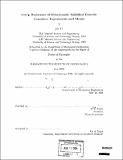| dc.contributor.advisor | Ali S. Argon. | en_US |
| dc.contributor.author | Yi, Jin, 1971- | en_US |
| dc.contributor.other | Massachusetts Institute of Technology. Dept. of Mechanical Engineering. | en_US |
| dc.date.accessioned | 2005-09-27T17:15:33Z | |
| dc.date.available | 2005-09-27T17:15:33Z | |
| dc.date.copyright | 2004 | en_US |
| dc.date.issued | 2004 | en_US |
| dc.identifier.uri | http://hdl.handle.net/1721.1/28602 | |
| dc.description | Thesis (Ph. D.)--Massachusetts Institute of Technology, Dept. of Mechanical Engineering, 2004. | en_US |
| dc.description | Includes bibliographical references (leaves 167-174). | en_US |
| dc.description.abstract | The creep resistance of the directionally solidified eutectic ceramic of Al₂0₃/c-ZrO₂(Y₂0₃) was studied in the temperature range of 1200-1520⁰C both exprimentally and by the mechanistic dislocation model. The topologically continuous majority phase of Al₂0₃ has a nearly perfect growth texture in the [0001] direction and encapsulates the minority c-ZrO₂(Y₂0₃) phase in a variety of morphologies. This encapsulated minority phase, too, has a close to < 110 > growth texture, regardless of morphology. The two phases are separated by well-structured interfaces. The tensile creep of the eutectic in its growth direction exhibits an initial transient that is attributed to stress relaxation in the c-ZrO₂(Y₂0₃) phase, but otherwise in steady state shows many of the same characteristics of creep in sapphire single crystals with c-axis orientation. The creep strain rate of the eutectic has stress exponents in the range of 4.5[similar to]5.0 and a temperature dependence suggesting a rate mechanism governed by oxygen ion diffusion in the A1₂0₃. Since the deformation is isolated in each phase and glide in any available slip systems is not possible, the recorded creep strain is derived from the diffusion-controlled climb of pyramidal edge dislocations in the Al₂0₃ phase, which is supported by TEM observations. The evidence suggests that the climbing dislocations in Al₂0₃ must repeatedly circumvent the c-ZrO₂(Y₂0₃) domains acting as dispersoids, resulting in the stress exponents larger than 3. The mechanistic dislocation creep model is in very good agreement with the experiments. Low angel boundaries in the form of asymmetrical tilt boundaries are found between columnar colonies in the crept specimens. These could have formed by the reaction of basal dislocations | en_US |
| dc.description.abstract | (cont.) and pyramidal dislocations, but generally were thought to result from aggregation of climbing pyramidal edge dislocations. The various possibilities of dislocation sources in Al₂0₃ are also discussed. | en_US |
| dc.description.statementofresponsibility | by Jin Yi. | en_US |
| dc.format.extent | 174 leaves | en_US |
| dc.format.extent | 11326280 bytes | |
| dc.format.extent | 11349725 bytes | |
| dc.format.mimetype | application/pdf | |
| dc.format.mimetype | application/pdf | |
| dc.language.iso | en_US | |
| dc.publisher | Massachusetts Institute of Technology | en_US |
| dc.rights | M.I.T. theses are protected by copyright. They may be viewed from this source for any purpose, but reproduction or distribution in any format is prohibited without written permission. See provided URL for inquiries about permission. | en_US |
| dc.rights.uri | http://dspace.mit.edu/handle/1721.1/7582 | |
| dc.subject | Mechanical Engineering. | en_US |
| dc.title | Creep resistance of directionally solidified eutectic ceramics : experiments and model | en_US |
| dc.type | Thesis | en_US |
| dc.description.degree | Ph.D. | en_US |
| dc.contributor.department | Massachusetts Institute of Technology. Department of Mechanical Engineering | |
| dc.identifier.oclc | 57518282 | en_US |
